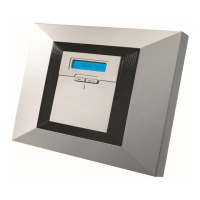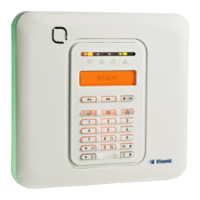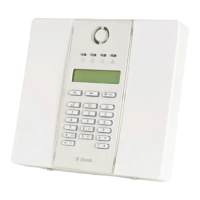INTRODUCTION
DE5468U 5
Moreover, you can obtain up to 8 multi-function
key-ring transmitters and proximity tags that will allow
you and other users to easily control major functions.
Proximity tags enable authorized people to enter
restricted areas. Presenting a valid proximity tag
while the system is armed causes the system to
disarm. Presenting a valid proximity tag while the
system is disarmed causes the system to be armed
in AWAY or HOME modes.
If the user has changed the state of the system from
a high security mode to a lower security mode i.e.
from ARM to DISARM, or from ARM to HOME, he
will be prompted to enter the user code thus
bypassing the QUICK ARM option.
The system identifies a wide range of events -
alarms, attempts to tamper with sensors and several
types of trouble. Events are automatically reported
via PSTN or optional GSM to central monitoring
stations (in digital form) and to private telephones (in
plain language and/or SMS messages). The person
receiving such a message is expected to investigate
the event and act accordingly.
IMPORTANT! All you need to know to secure your
premises can be found in Chapter 2 of this manual.
If you are not familiar with some of the terms used
here, refer to Appendix A at the end of this guide.
System Features
Your PowerMax Pro offers a large number of unique
features:
• 30 zones: Each protected zone is identified by
number and by name.
• 4 Partitions (optional): One of the PowerMax
Pro’s advantages is its ability to divide the system
into a maximum of 4 partitions. Each partition may
be viewed as a separate security system, each of
which can be armed and disarmed individually
regardless of the condition of the other partitions.
• Multiple arming modes: AWAY, HOME, AWAY-
INSTANT, HOME-INSTANT, LATCHKEY and
BYPASS.
• Liquid crystal display (LCD): Plain-language
status information and prompts are displayed on
the front panel in large, clear letters.
• Real-time clock: The present time is visible on the
display. This feature is also used for the log file by
providing the date and time of each event. In
addition, it is used for the Scheduler where activity
of a sensor is performed according to a specific
time and date selection.
• Various reporting destinations: Events are
reported automatically to central monitoring stations,
private telephones of your choice, to a pager and
even by SMS if GSM is installed.
• Selective reporting: Your installer can determine what
type of event will be reported to which destination.
• Latchkey mode: An automatic “Latchkey” message
is sent to chosen telephones if the system is
disarmed by a “latchkey” user (a junior family
member, for instance).
• Spoken announcements and instructions:
Status- dependent, pre-recorded verbal messages
are heard over the built-in loudspeaker (if the voice
prompts are enabled - see chapter 7).
• Message exchange: Before leaving the premises,
you may record a short verbal message for other
users of the system who may arrive later. Upon
arrival, you can listen to verbal messages left by
others for you.
• Access from remote telephones: You may
access the PowerMax Pro from a remote
telephone and Arm/Disarm it or receive system
status information.
Note for PowerMax Pro with Partition feature:
Remote operation is performed per partition, or per
user code defined for a particular partition.
• Numerical keys serve as function keys: In the
disarmed state, numerical keys are used to control
various system functions. A simple icon on each
key identifies the task of that key.
• Electrical sensor control: Lights and electrical
appliances can be controlled if optional X-10
modules are used. The electrical cabling network
of the premises carries the control signals. Your
installer will determine the control means in
accordance with your needs.
• PGM remote control: Gate control mechanisms,
courtesy lights and various other sensors can be
switched on and off via a special PGM
(programmable) output. Your installer will determine
the control means, in accordance with your needs.
Note for PowerMax Pro with Partition feature:
The X-10 and the PGM outputs operate on the
entire alarm system and not per partition.
• Data retrieval: You can obtain status information,
trouble information and review memorized alarm
events - visually and verbally.
• Looking after elderly, physically handicapped
and infirm individuals: The system can be
programmed to monitor activity within the protected
area and send out an alert message if the person
under surveillance remains still for a predefined
period of time (as set by your installer).
• Distress calls: Miniature pushbutton transmitters
dealt out to specific individuals may be used for
sending emergency calls for help.
•
Disarming under duress: If a user is forcibly
compelled to disarm the system, he can use a
special code that disarms the system apparently as
usual, but sends a silent alarm to the central station
(see chapter 2).

